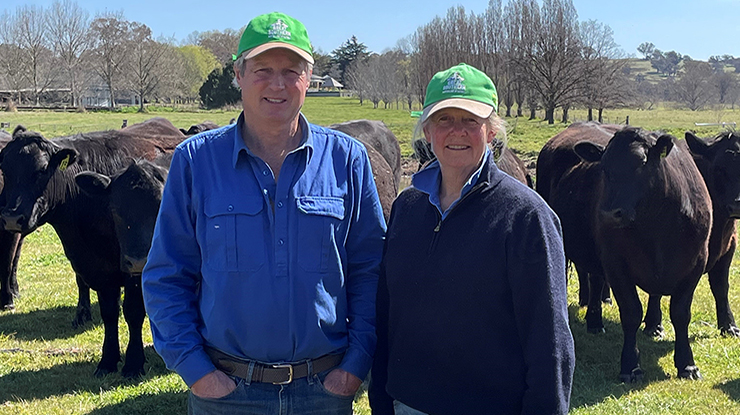 Roger and Missy Wilkinson won the 2023 MSA Excellence in Eating Quality Award for NSW large non-grainfed producers.
Roger and Missy Wilkinson won the 2023 MSA Excellence in Eating Quality Award for NSW large non-grainfed producers.
When it comes to maximising weight gain and carcase performance, a low-stress approach has proven successful for NSW beef producers Roger and Missy Wilkinson.
The Wilkinsons, who run a steer-trading enterprise near Bathurst with their daughter Primrose, won the 2023 MSA Excellence in Eating Quality Award for NSW large non-grainfed producers.
Roger and Missy have specialised in steers for more than 20 years. They’ve been MSA producers since 2011.
Over the past two years, they consigned more than 900 head and achieved an average MSA Index of 65.16 and a high compliance rate of 97%.
It’s an exceptional result given the Wilkinsons don’t breed any of their own cattle, instead buying them in via a trusted commission buyer who selects on type and temperament over specific genetic lines or suppliers.
The buyer is based in Wagga Wagga, and the Wilkinsons generally source steers from southern NSW and northern Victoria.
Type and temperament
Roger said specific genetics haven’t typically played a role in their results – their achievements are better attributed to the type of cattle bought and the way their nutritional requirements are managed.
“Temperament and type are probably the main things we look for, seeking out quiet cattle who are later maturing,” Roger said.
Originally the Wilkinsons bought steers in at around 300kg. Today, they target an entry weight of 350kg and find the cattle perform better.
“Buying them when they’re that little bit older, we find they go on a bit faster, metabolise better and are easier to handle,” Missy said.
“They’re also through the stress of weaning, rather than having come straight off their mothers.”
The Wilkinsons have found handling and management to be key drivers of performance for their steers, to meet their target of supplying 400–410kg carcase weight to JBS Scone.
On-farm strategies
On arrival, steers are unloaded into holding paddocks and left to settle for a week or two, before being brought in, weighed, drenched and vaccinated. They are then grouped into mobs of about 40 head of similar weights and placed into paddocks with improved pastures.
“From there, we really try to leave them alone as much as possible. We avoid mixing mobs during their time on the farm as they are very social, and become comfortable in their familiar paddock,” Roger said.
Since focusing on trading steers, the Wilkinsons have gathered a lot of data on weight gain and meat quality.
“As a result, we’ve changed some of our management practices, particularly around not mixing and moving cattle unnecessarily as this can have a big impact on weight gains for a number of months.
“We closely monitor our stocking rate overall and at the individual paddock level, as well as assessing the available feed in the paddocks to ensure all the steers are on a rising plane of nutrition and the pastures remain in a healthy state.”
Low-stress stock handling and improved technology in the cattle yards have also helped the Wilkinsons get better results with their steers.
“We upgraded the yards recently and have started using a Tru-Test weighing system which gives us immediate average daily weight gains, alongside realtime weights,” Missy said.
“It gives a good and timely indication of nutritional value in the paddocks, and if we see cattle weight gains start to slide, we can intervene before it’s too late.”
Value of data
This management style has been supported by the objective data and measurement tools the Wilkinsons use through myMSA.
“Initially we moved to MSA because it allowed us to differentiate our product from standard cattle and it is now a requirement for our farm assurance program,” Roger said.
“We really rely on the MSA feedback to understand our performance and make changes where we need to.
“Getting objective measurement helps you understand how your management style is impacting the end product, and you can make business decisions based on that.”
The objectivity of MSA and the eating quality measurements also allow producers to connect in a meaningful way with others in the supply chain.
“It gives producers, processors and end consumers some common ground and a framework to work out how we can best complement each other,” Missy said.
Lessons learnt
|






